The Grapevine Art & Soul Salon
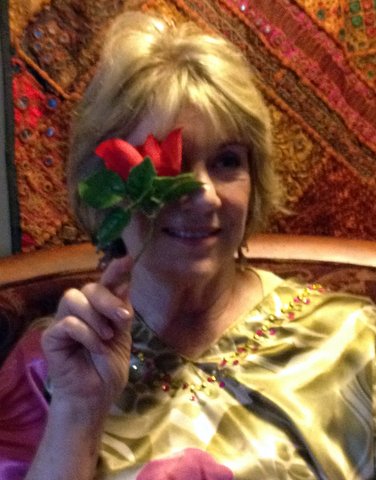
AROUND TOWN WITH NANCY ROSE
My Visit to Lerwick in the Shetland Islands
A Viking longboat river cruise in 2017, sailing from Amsterdam to Budapest, was the occasion for my meeting Freya and Elizabeth (called Biz). A longboat holds fewer people than an ocean liner, only about 225 compared to as many as 3000, so it is easier to meet people. I learned they were born and raised in Lerwick, Shetland, where they still live. Both were employed as social care workers at Shetland Isles Council. Biz has since retired.
I was familiar with Lerwick (pronounced Lair ick) as the setting of the BBC mystery/detective drama Shetland, based on the Shetland Islands novels by Anne Cleeves, and starring Douglas Henshall as DI Jimmy Perez. I love everything about the show: town, plots, characters, accents, scenery. Although DI Jimmy Perez is a native Shetlander, he has a Spanish surname because he is a descendant of a Spanish Armada sailor shipwrecked off the coast of Fair Isle, Jimmy Perez’s birthplace. I’ve watched four seasons and am anxiously awaiting season five, when I will set aside a couple of days to binge-watch it.
Of course, Biz and Freya were familiar with the television series and reported that they have often observed television crews filming scenes in the area, adding that Steven Robertson, who plays Detective Constable Sandy Wilson, was born in Lerwick. I loved listening to their captivating accents as they talked happily about their hometown and the show. We shared lots of information about ourselves, and I suspect they noticed my accent, too, coming from the southeast U.S.A. Here are a couple of new words I learned : spaegie (n) "stiffness or pain in back or legs caused by over-exertion. I walkit for miles dastreen and noo me legs is aa spaegie." knap (v) "to speak English; to talk 'proper'; sometimes also used in a derogatory reference to a Shetlander speaking in an affected way. Boy, is du really needin to be knapping lack a fol?" (from Wirds fae Shetland)
Through socializing at dinner with cocktails and participating in some of the same excursions, like the one where we all learned the Viennese waltz in Vienna, we became good friends. One evening on board we became trivia partners. We didn’t win but scored well, thanks mainly to their knowledge of music and movie trivia.
When it came time to say goodbye at the end of our cruise, we exchanged emails to stay in touch and even promised to visit each other if ever the opportunity arose. To my surprise, that occurred in August the following year. Earlier in the summer my neighbors had begun talking about a European cruise they were taking in August/September and had asked if I was interested in going. I looked at the itinerary, which included stops in Skagen, Denmark; Stavanger, Norway; Lerwick, Shetland; Reykjavik, Iceland. The stop in Lerwick caught my attention. Here fate was presenting me with the opportunity to visit Biz and Freya.
I immediately began preparations to cruise, meanwhile contacting Pam, a friend in Birmingham, to see if she was interested. By the end of the day, we had our reservations and passports ready. I sent a message to Biz and Freya that I would be on the Serenade of the Seas cruise and the ship would dock in Lerwick for one day, on August 29. Would it be possible to meet them for lunch? I received an immediate response that not only could we have lunch, but they would meet Pam and me at the ship when it docked at about 9:00 a.m. and take us on a tour of Lerwick.
In preparation for my visit I did some research because I wanted to know more about Lerwick than what I saw in the television program. Encyclopedia Britannica describes Lerwick as the “most northerly town in Great Britain,” 600 miles north of London. Established by the Scandinavian Vikings, it is the capital and largest city of the Shetland Islands, with a population of approximately 7500. Shetland Islands is “an archipelago lying 130 miles north of the Scottish mainland,” with the Atlantic Ocean to the west and the North Sea to the east.
Lerwick is an Old Norse word which means bay of clay. Similar Norwegian city names are Leirvik and Lervik. The name of my new friend Freya is Scandinavian, from the Norse goddess Freyja, and means Goddess of Love, Fertility and Beauty.
Shetland belonged to Norway until it was given to Scotland in the mid-fifteenth century. The islands are on the North Sea Cycle Trail where there is a l8-hole golf course. Lerwick is famous for its abundance of herring, for the oil boom in the l970s, for Shetland ponies, sheep, and Jamieson wool. It has its own gin distillery. Cyclists love the area because there are few automobiles. Over the years, Lerwick has become a popular tourist attraction for cruise ship passengers.
At approximately 9:30 on August 29, because the harbor is not big enough to accommodate ocean liners, tender boats transported passengers from the cruise ship to the Lerwick dock. As Pam and I walked down the dock, I immediately saw Biz and Freya and began waving. We greeted each other with hugs and laughs and introductions.
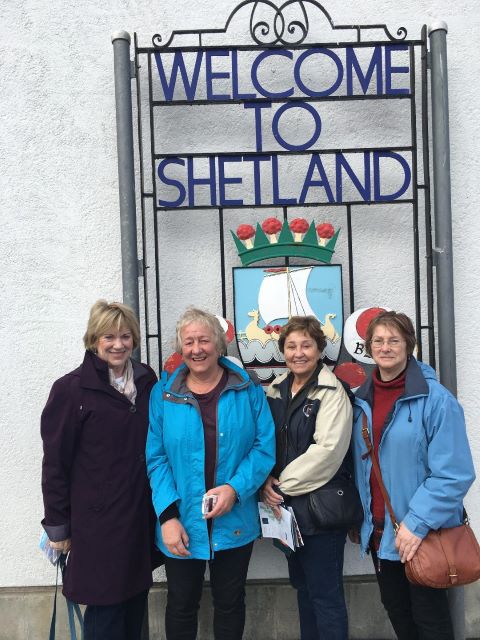
Since we would be there for only about five hours, Biz and Freya suggested that to make the most of our time, we should begin with a walking tour of Lerwick and then drive to the outlying rural area to see the Shetland ponies and historical monuments.
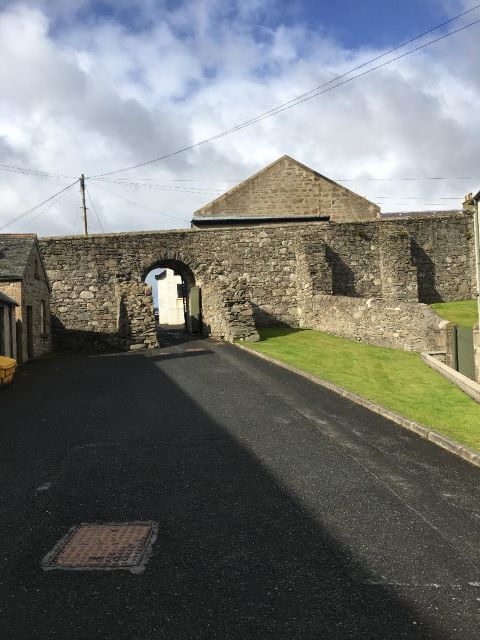
We started our tour at Fort Charlotte, named after the wife of King George III, which is across the harbor and up the hill. Fort Charlotte was first built in 1652-3, destroyed, built again in 1665, then burned by the Dutch in 1673. In 1781 it was rebuilt for a third time. During the Napoleonic Wars, the fort housed a garrison and later served as a base for the Royal Naval Reserve. Today it is managed by Historic Scotland and is the site for Shetland’s Territorial Army.
From Fort Charlotte we walked up the steep hillside to the lanes area where we stopped at every store on Commercial Street, the main street in town. Biz and Freya knew a lot of people, greeted them and introduced Pam and me.
My favorite stores were Jamieson and Smith Shetland Wool and Shetland Reel Gin. The wool store was filled with beautiful yarn of many colors and handknit products such as scarves, sweaters, capes and blankets. Colorful Shetland sheep are prized for their beautiful wool. You may be familiar with Shetland Isles multicolored knitwear. The knitwear is made using the Fair Isle knitting method, also known as stranded colorwork knitting, a technique for working two (or more) colors of yarn in the same row. Another famous product is the traditional knitted lace shawl made from Shetland sheep wool, using a pattern called Fir Cone lace.
Here is a link to Shetland Wool Week, usually held at the end of September, “a celebration of Britain’s most northerly native sheep, the world renowned textile industry and the rural farming community on these islands.” Shetland Wool Week
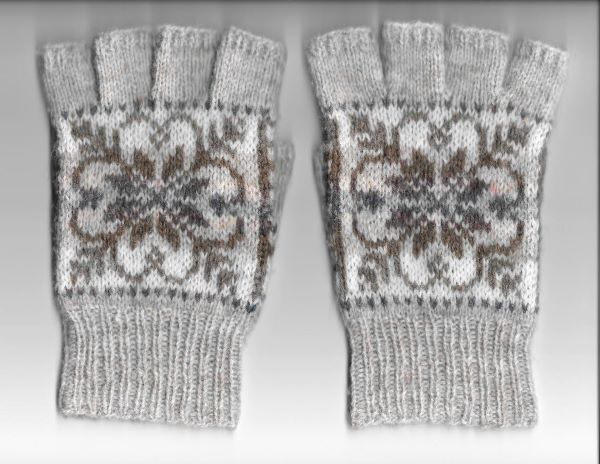
A couple of doors down the street was Shetland Reel Gin, Shetland’s only distillery. I bought a sample pack of their three flavors—"original," "ocean sent" and "simmer"—to bring home. The three flavors are described on the company’s website at www.shetlandreel.com. I am quoting them here so readers can get the full flavor not only of the gin, but of the only place where it is made.
SHETLAND REEL ORIGINAL GIN Our award winning craft gin affectionately captures the nature of our island. Our signature recipe uses the sweet scented leaves of apple mint grown and harvested on Unst giving a unique authentic flavour of Shetland.
SHETLAND REEL OCEAN SENT GIN Influenced from the seas that surround our island, Ocean Sent Gin features native bladderwrack. The distinctive and nutritious seaweed is gathered from the rocks of the Shetland coastline and distilled to our unique recipe resulting in a surprising depth of flavour from the shores of Unst.
SHETLAND REEL SIMMER GIN Inspired by our magical skies, Simmer Gin is a refreshing aromatic gin created in celebration of Shetland's summer twilight, know locally as the Simmer Dim. The long summer days and lasting amber skies at sunset influence the eight botanicals in our recipe including orange peel and liquorice root.
The website also features recipes for cocktails with intriguing names like Simmer Dim Sour, Tomas Collinson, Shetland Bramble, Norwick Martini and Viking Sling.
After walking up one side and down the other of Commercial Street, we went on to The Havly on Charlotte Street for lunch where we ordered Reestit Mutton Tattie Soup (described as Scotland’s national dish) with homemade oatcakes fresh from the oven. They were delicious, as was the soup, which tastes like a light version of potato soup with added mutton and turnips.
Footnote: Later, I learned that Reestit Mutton is “a variation of the Scandinavian skerpikjřt, an air dried mutton, or vivda, Norse for 'leg meat'.” It is a traditional Shetland way of preserving mutton with salt for consumption during the winter months. The mutton is first salted in brine and then traditionally hung in the rafters (reest) of houses, where the peat smoke will add flavour and help preserve the meat.
A recipe for Reestit Mutton Soup that serves six people, takes 15 minutes to prepare, and cooks for 2.5 hours, requires two pounds of Reestit mutton with cold water to cover, boiled for two hours or until tender. Then you remove the meat, reserving a ladleful of the cooking water, skimming off the fat, and adding more water or lamb stock to your own taste. Also, add and boil until tender one finely diced onion, as well as 300 grams of potatoes, 225 grams of turnips, and 200 grams of carrots, all peeled and finely diced. Finally, add the mutton, finely chopped, for a few more minutes of cooking and serve hot with buttered bread.
After lunch we continued our tour, stopping to take pictures at the Lerwick police station.
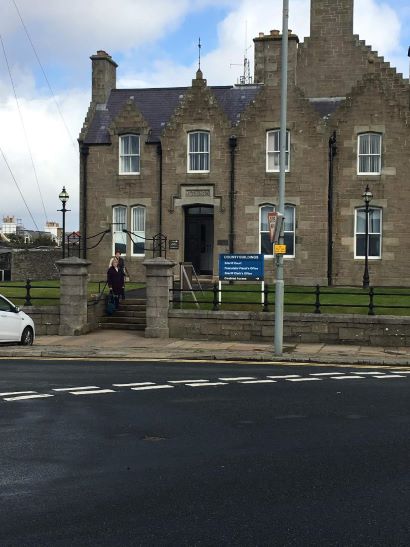
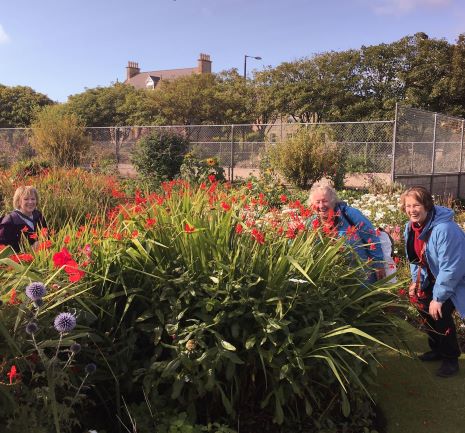
In the back are walking trails with benches, a sheltered picnic area and even lawn bowling. Then we returned to the car. Shetlanders must be in good physical shape. I was exhausted from walking up and down those hilly streets and ready for a driving tour.
Biz drove us a few miles outside of Lerwick, where we hoped to see the bonny Shetland ponies known for their thick, long manes and tails, that graze in acres and acres of open pastures. We did see some from the road. Biz pulled off to the side, and we walked up the hill to get a closer view. They are intelligent, rugged, strong animals, with short legs and heavy coats that come in colors of gray, bay, chestnut, roan, dun, and brown. Some have spotted white and dark patches. The ponies, indigenous to Shetland, must be accustomed to being admired by visitors. When we approached them, they walked over as if they expected to be petted and have their picture taken with us. What a thrill!
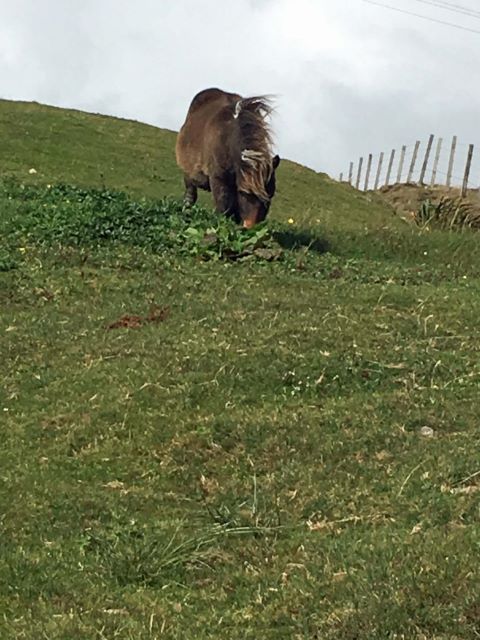
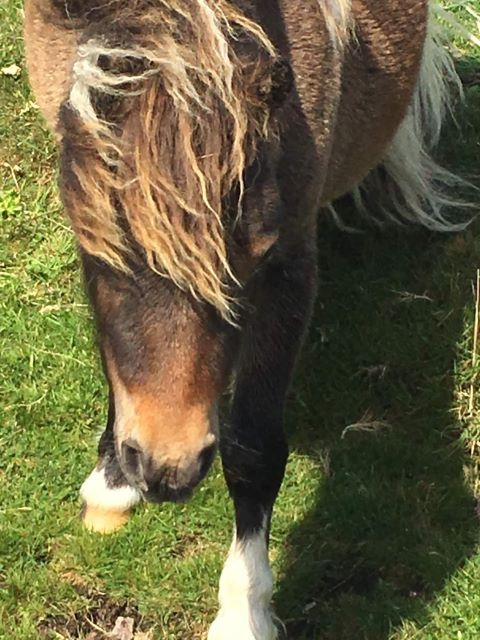
We continued driving, and on the outskirts of town near a small lake, Freya pointed out a Brough (a small town) where the Picts lived over 5,000 years ago. According to Encyclopedia Britannica, the name Picts “may refer to their custom of body painting or possibly tattooing.”
We saw the Wormadale Hill Stone monument. Standing stones are prevalent throughout Scotland, indicating the presence of prehistoric people. It is believed they formed part of larger structures such as henges (“round, flattened areas surrounded by a boundary earthwork, usually consisting of a bank and/or a ditch”), stone circles and cairns (“human-made piles of stones built on a hilltop”), all used in religious and holiday celebrations. (Encyclopedia Britannica)
The day had passed quickly; now it was mid-afternoon and time to return to the ship. At the harbor Biz parked and we all walked to the dock. We took more pictures, gave more hugs and expressed our thanks over and over.
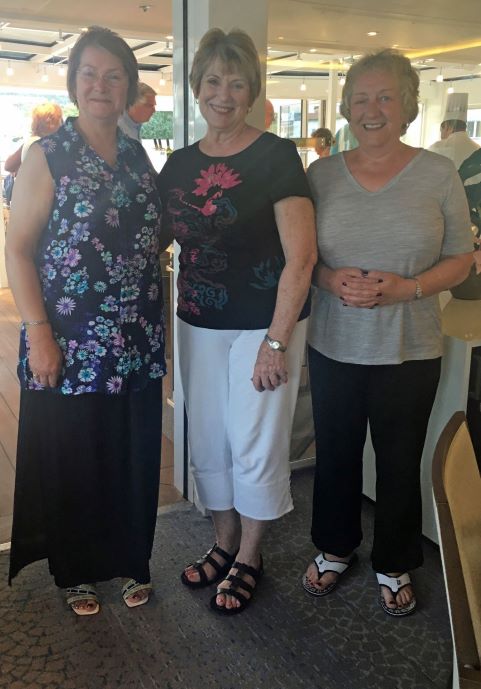
Biz and Freya love traveling. Since they haven’t been to the southern United States and they both love country music, I hope to entice them to visit me, with a promise to take them to Nashville.
TO FREYA AND BIZ: Thank you for your kindness, your generosity of time and your pride in sharing your history and customs. I look forward to your visit when I can reciprocate with what we call southern hospitality.
Copyright 2019, Barbara Knott. All Rights Reserved.